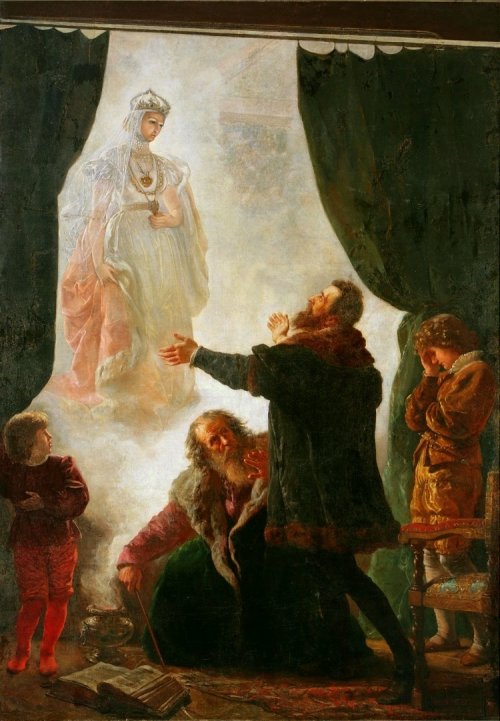Ellen Lloyd – AncientPages.com – There are stories about people who will do anything to gain special powers in folklore, myths, and legends.
Those who sell their soul to the Devil in reward for something special often meet a tragic fate. This was the case with the sorcerer and magician Pan Twardowski who made a pact with dark forces, which he regretted later. Pan Twardowski (which means Mr. Twardowski in Polish) is a person one can read about in Polish folklore books.

Pan Twardowski and the devil. Drawing by Michal Elwiro Andriolli. Credit: Public Domain
There are several versions of the Pan Twardowski tale and scholar suggests his story bears a striking resemblance to the German story of Faust. Those familiar with the tragic Faust play written by Johann Wolfgang von Goethe will remember the man’s desire to acquire knowledge. Feeling despair over his life, Faust summoned spirits, and his journey with the Devil got him in unexpected trouble. Feeling disappointed in what natural science had to offer, Faust turned to magical means to understand the secrets of nature and the Universe.
The story about Pan Twardowski is similar. Like, Faust, Pan Twardowski begins with summoning a spirit. Pan Twardowski, who, according to an old legend, was a nobleman living in the Polish city of Kraków in the 16th century, comes in contact with the spirit of the Polish King Sigismund Augustus’ deceased wife.
The Polish sorcerer thinks the Devil can grant him special powers. He also feels that he is clever enough to fool the Master of the Darkness. Being cunning, he includes a special clause in the contract, stating that the Devil could only take Twardowski’s soul to Hell during his visit to Rome. He does not tell the Devil that this is a place the sorcerer never intends to go.
As Pan Twardowski’s contact with the Devil reaches new proportions, the Lord of Darkness grants the knowledge seeker aid to become rich and famous. Later, Pan Twardowski is even given the opportunity to be a courtier of King Sigismund Augustus, who sought consolation in magic and astrology after the death of his beloved wife, Barbara Radziwill. Using a magic mirror and a book written by the Devil he successfully sums up the ghost of the late queen to comfort the grieving king.
Pan Twardowski also manages to avoid his fate for several years. However, on one occasion realizes the Devil cannot be fooled forever. One day, the Devil catches the sorcerer in an inn and demands the sorcerer to fulfill his obligations. Pan Twardowski starts praying to Virgin Mary, but it is too late. Both the Devil and Pan Twardowski ended up in Hell. There are also older legends that tell Pan Twardowski fell on the Moon, where he still resides.
Spirit communication was common among scholars long ago. “During the Renaissance, many became interested in magic and mysticism. Science was in its early stage and curious minds sought answers to big questions in spiritual science.
The Renaissance was a time when scientists made great advances in fields like geography, astronomy, chemistry, physics, mathematics, manufacturing, anatomy, and engineering. Near the end of the Renaissance, the scientific revolution began, but before this could happen people turned to magic and occult forces that became accepted parts of early modern science.
Relying on magic was only natural to early Renaissance scientists like for example, Paracelsus (1493 – 1541), a Swiss-German botanist, philosopher, astrologer, alchemist, and one of the most influential medical scientists in early modern Europe. Prophecies were appreciated by royals. French Queen Catherine de Medici, for example, supported Nostradamus.

Pan Twardowski summoning Barbara Radziwillówna’s ghost for King Sigismund Augustus. Painting by Wojciech Gerson. Credit: Public Domain
Although magic played an influential role in Renaissance thought, some practices were considered doubtful. This was especially dangerous if a person was suspected to call upon demons and the Devil to use their powers for his own benefit.” 1
Another man who engaged in dangerous spirit communication was Eugenio De Torralba (1485 – 1531) who later became Spain’s famous magician.
In Iceland where folklore magic is a popular subject there are many stories about people who performed extraordinary magical feats and achieved amazing things.
“Records of Icelanders’ magical beliefs and practices can be found in many ancient books and manuscripts that have been preserved for future generations.
One curious story reflecting a mixture of Christian and Pagan elements deals with the story about how Sæmundur Sigfússon (1056 – 1133) tricked the Devil, but not just once, but three times. Each time he used a different trick making the Devil confused.” 2
Folklore stories mixing the Devil’s encounter with humans are pretty common, and many of them were meant to warn not to become too interested in dark forces.
Written by Ellen Lloyd – AncientPages.com
Copyright © AncientPages.com & Ellen Lloyd All rights reserved. This material may not be published, broadcast, rewritten or redistributed in whole or part without the express written permission of AncientPages.com and Ellen Lloyd
Expand for references
- Ellen Lloyd – Eugenio De Torralba – Renaissance Magician’s Dangerous Spirit Communications, AncientPages.com
- Ellen Lloyd – How Sæmundur The Wise Tricked The Devil Three Times, AncientPages.com





